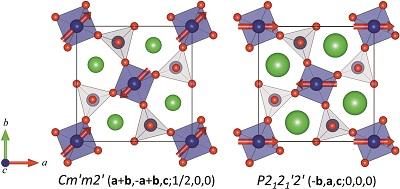
This is the magnetic structure of a multferroic material taken from the database in (a) and (b) with different magnetic symmetry and no multiferroic character. Source: Hutanu et al., 2012
The quantitative characterisation of the magnetic ordering realised in magnetic phases is an essential part of research into the magnetic properties of solids. It is certainly fundamental for the cross-checking of theoretical models and for the exploration of complex solid-state magnetic phenomena. Furthermore, the determination of magnetic structures, mainly using neutron diffraction data, is a fundamental step in the search for functional materials for magnetic and/or magnetostructural applications. Since the first report of a magnetic structure determined from neutron diffraction data in 1949, the magnetic structures of thousands of compounds have been investigated and reported. In 1976, an important effort was made to gather information available on all the magnetic structures known at that point, and a compilation of about 1000 magnetic structures was published. This effort continued with an additional listing of about 100 structures in 1984. Since then, experimental facilities, instruments and analysis methods have improved enormously, and hundreds of magnetic structures are being reported each year. It is estimated that, at the moment, there must be about 5000 published magnetic structures. In this scenario, the convenience of a digital database of magnetic structures seems clear, but despite some early work in this direction, the lack of standards in the description and communication of magnetic structures has precluded the development of an appropriate computer database.
Two recent developments have, however, opened up new possibilities for the systematic application of magnetic symmetry and the achievement of a standardised framework for the description and digital storage of magnetic structures.
Within this framework, a group of scientists from Spain, Turkey, USA and Japan have collected at the Bilbao Crystallographic Server, under the name MAGNDATA, comprehensive information on more than 400 commensurate and incommensurate magnetic structures. MAGNDATA is intended to be a benchmark and starting point for a complete database of magnetic structures, where magnetic symmetry is systematically employed and the magCIF format is the communication file format.




